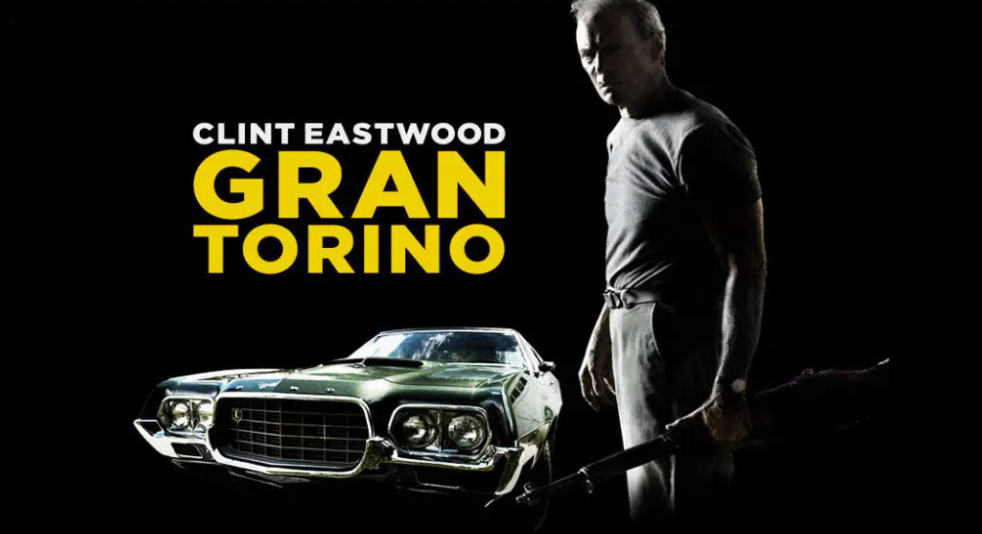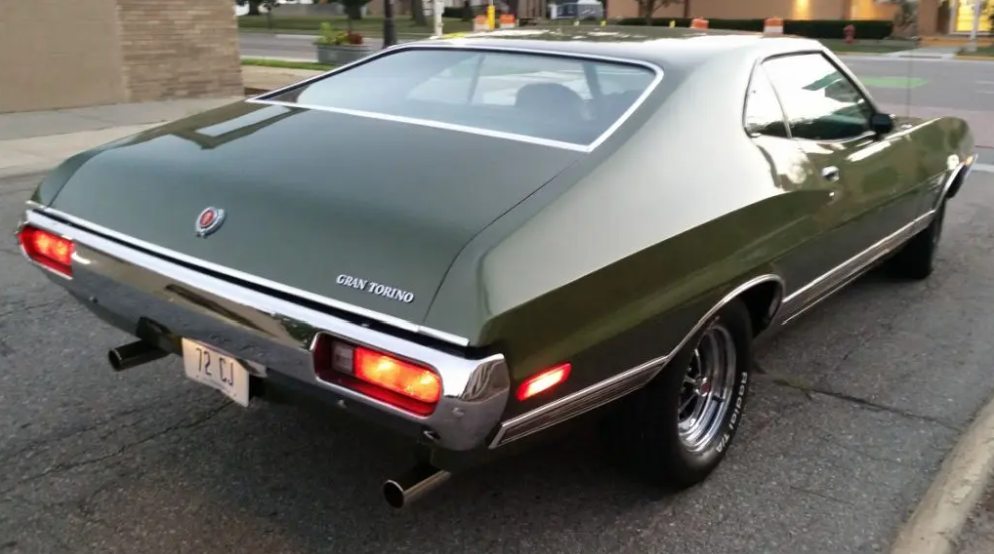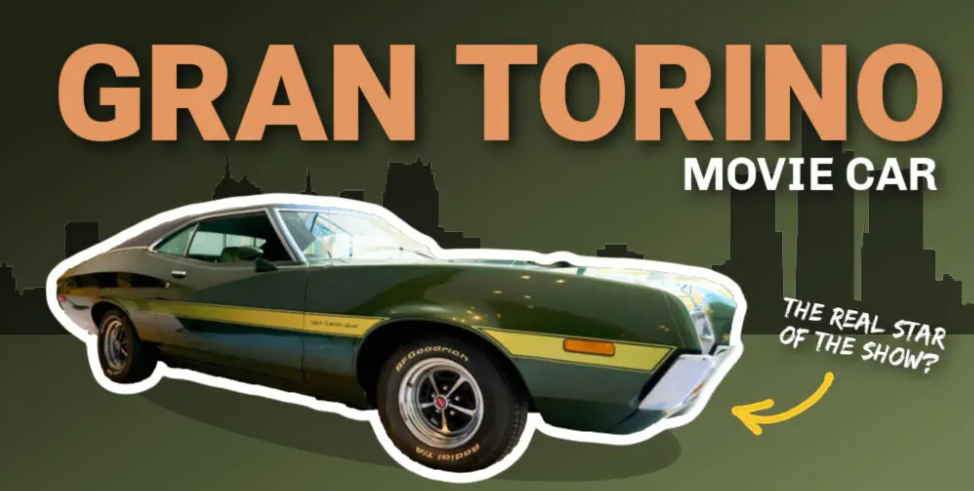In Clint Eastwood’s 2008 film Gran Torino, the title car isn’t just a vintage muscle machine—it’s a full-fledged character. With its deep green paint, broad stance, and thunderous V8 rumble, the 1972 Ford Gran Torino Sport doesn’t merely sit in the driveway—it commands the screen. Like its owner, Walt Kowalski (played by Eastwood himself), the car is tough, stubborn, and steeped in a bygone era.

More than just a prop, the Gran Torino is the soul of the film, symbolizing America’s golden age of manufacturing, the pride of personal craftsmanship, and the difficult but rewarding bridges we build across cultural divides.
From Factory Floor to Film Fame
Produced from 1968 to 1976, the Ford Torino line was Ford’s answer to America’s appetite for mid-sized muscle cars. But by 1972, the Gran Torino had evolved into something special—a blend of Detroit engineering and dramatic flair. Its design was reimagined that year with a long, sweeping body, wider stance, and an unmistakable sports roof that gave it a fastback feel even when standing still.
That year, three trim levels hit the market: the standard Torino, the upscale Gran Torino, and the high-performance Gran Torino Sport. The Sport, with its muscular lines and optional high-powered engines, quickly became a standout, especially among younger drivers craving speed and style.
Under the hood, options ranged from a 302-cubic-inch V8 to the formidable 429 Cobra Jet. But the most famous among them—and the one immortalized in Gran Torino—was the 351-cubic-inch Cobra Jet V8, delivering 266 horsepower and a signature growl that echoed the grit of the American heartland.
A Car with Character
In the film, Eastwood’s character, Walt Kowalski, is a retired Ford assembly line worker who actually helped build the Gran Torino he now treasures. It’s more than a car to him—it’s the last remaining symbol of a world he once understood. For Walt, the Torino embodies his life’s work, his pride in American craftsmanship, and his resistance to the changes swirling around him.

But the car does more than reflect who Walt is—it pushes the plot forward. It becomes a point of conflict, a source of admiration, and ultimately, a vehicle (both literally and figuratively) for transformation.
Walt’s initial prejudice toward his Hmong neighbors gives way to understanding, largely sparked by the admiration that young Thao shows for the Gran Torino. When gang members pressure Thao to steal it, a chain reaction is set off—one that leads Walt to confront his past and choose redemption over bitterness.
The Gran Torino becomes the unlikely bridge between cultures and generations, and in the film’s final moments, it represents a legacy passed on—not of material wealth, but of values and connection.
Inside the Machine
The 1972 Gran Torino Sport was built for drivers who wanted both power and flair. A standard three-speed manual transmission provided classic control, while options like a four-speed manual or three-speed automatic added variety. Power brakes and optional front disc brakes ensured stopping power to match the go.
Inside, the Gran Torino Sport mimicked high-back bucket seats even with its full bench, marrying form with function. Add in the signature Magnum 500 wheels and sleek instrument panel, and you had a muscle car that felt like it belonged in a showroom and on a racetrack.

A few quick specs:
- Horsepower (Cobra Jet V8): 266 hp
- Curb Weight: ~3,500 lbs
- Body Style: Two-door “Sports Roof”
- Top Trim: Gran Torino Sport
- Original Base Price: $2,822
- Rarity: Only 3,939 convertibles made in 1972
A Legacy Cemented in Steel
After the release of Gran Torino, interest in the 1972 model skyrocketed. Collectors and car lovers alike scrambled to get their hands on one. And why not? With its aggressive design, powerful engine lineup, and cultural cachet, the Gran Torino became more than a car—it became a legend.
But the story doesn’t stop at cinema. The Gran Torino’s image has since appeared in video games, music videos, and countless pop culture references. It’s found its place alongside other iconic movie cars, like the Bullitt Mustang, John Wick’s 1969 Mustang, and the Fast & Furious Charger.

One especially touching footnote is the story of Dave Beckett, who once owned the exact Gran Torino Sport featured in the film. After watching the movie and recognizing the vehicle, he tracked it down and was able to visit it at Warner Bros Studios’ car museum. Incredibly, the key he had kept all those years still fit the ignition—a poetic nod to the lasting bond between man and machine.
Where Is the Gran Torino Now?
After filming wrapped, Eastwood reportedly added the car to his personal collection. Today, it’s housed at the Warner Bros Studios Picture Car Museum in California, where visitors can see the vehicle that helped define one of Eastwood’s most personal and powerful films.
And if you’re wondering about its market value: depending on condition, a 1972 Gran Torino Sport with the Cobra Jet engine can fetch anywhere between $13,000 and $40,000. But for fans of the film, its true worth is far greater.

Final Thoughts
The 1972 Ford Gran Torino isn’t just a car—it’s an emblem of identity, pride, and redemption. In Eastwood’s Gran Torino, it becomes the heartbeat of the story, tying together past and present, old wounds and new beginnings. For a film about legacy, understanding, and finding peace in unlikely places, it’s only fitting that the title belongs not just to the man, but to the machine that drives his transformation.
More than steel and horsepower, the Gran Torino represents a way of life—a reminder of what we build, what we hold dear, and the bridges we can form when we open the garage door and let someone new into our world.




